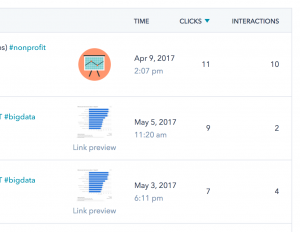
You can find tons of techniques in a Google search for blog post ideas. But usually, these include a list of topics that someone else already brainstormed. They may or may not be relevant to your business.
So what good are someone else's ideas if they don't relate to your audience — and, of course, move your own audience to action?
The majority (60%) of B2B marketers report that their biggest challenge in 2016 will be producing engaging content. – Content Marketing Institute
Thankfully, data never lies. And data-driven decisions are our forte at Ironpaper, and they can be yours, too. Here are five ways to find blog post ideas based on measurable audience data.
If you're using social media for lead generation, you're probably posting a mix of your own content and other users'.
Therefore, social media can be a great "audience survey" of sorts to see what's resonating with your audience, and find blog posts ideas that they already want to read.
Using your social tool, sort posts by the number of click-throughs they received. This will show you which topics are buzz-worthy and grabbing the attention of your audience.
The more you curate content, the bigger pool you will have to analyze.

In this example, I may identify a need to write more about #nonprofit and #bigdata topics.
You probably have dozens or even hundreds of posts in your content archive. So if you're not looking back to see what's resonating, you're ignoring a huge data point.
But what metrics should you look for? You could measure things like bounce rate, time on page, social shares, and more. Yet if you want a blog that generates leads, you should focus on post that received the most conversions. That is, visitor-to-contact conversions. And not only new contacts (which might include spam or low-quality submissions), but new contacts that are actually qualified leads.
This metric will point you to blog post ideas that resonate with your target prospects, not just anyone.

Tip: Install Google Page Analytics extension for Chrome to see sessions with conversions on page.
By tracking keyword performance, you can also get your finger on the pulse of what people are searching for.
We use a keyword tracker like HubSpot to see how a term performs over time. If you notice searches are increasing, it may be time to strike on a particular topic. And if your own content is improving in ranking, it may be the momentum you need to create more content on the topic.
As an SEO tip, don't focus all your efforts around one keyword, though. Spread out your keywords semantically around one core topic.

Tip: If you use HubSpot's keyword tool, you can see insights like this above on if the keyword target is a sound one.
The right organically ranking posts can often bring in the best, most qualified leads, because they come into your website with intent.
Reading one Tweet is anecdotal. But reading dozens or hundreds of Tweets can become research.
Therefore, you should set up social monitoring streams to track the topics that matter to your personas.
You can do this in several ways. First, create lists of users that are relevant targets of yours. For example, if you're targeting CIOs, track top IT professionals in their personal profiles. Then, watch which hashtags they use, the questions they ask, and the discussions they have.
Second, you can monitor hashtags, such as #bigdata or #IoT, to follow buzz on those topics.
 You can use a tool like HubSpot to monitor social media streams for keywords, hashtags, or users.
You can use a tool like HubSpot to monitor social media streams for keywords, hashtags, or users.
Not only will this help you identify topics for blog post ideas; It will also show you insider hashtags to use that influence your audience.
Even better, supplement your research on Twitter and LinkedIn with a quick search on Quora or Reddit, to see if people are truly asking those questions.
Don't forget your best resource — your existing customers! You should be interviewing your customers for several reasons, such as to create case studies, but also to get a sense of their buying journey.
For example, you should ask:
Naturally, you should ask more specific questions to your industry. And like any good interview, you should dig deep into the answers to understand motivations.
When you get answers to these questions, you will have a new source of blog post ideas that is driven by actual customer problems, and how they move through the buying journey.
With these five methods, not only will you fill your content calendar, but you'll spend your time wisely on blog post ideas that generate great leads.
by Jonathan Franchell, CEO of Ironpaper - For more tips and hacks: Need to remove a new line after h1 tags? Both web designers and SEO practitioners need to employ headline tags: H1, H2, H3 in several ways to improve web page structure and tag...

The Crowded Arena of the IT Marketplace Updated December 2024 The Information Technology (IT) landscape is experiencing rapid growth and intensifying competition. IT spending is projected to reach nearly 5.1 trillion U.S. dollars in 2024, a...

Updated December, 2024 The field of digital marketing is evolving rapidly in response to new technology and changing buyer expectations. To help career-minded marketers, we’ve rounded up the top 10 skills needed to succeed in the field. These are...

The marketing industry is transforming significantly due to generative AI and increasing market complexity. Gartner's prediction of a 25% decline in traditional search traffic suggests that the era of search engines is dying. AI tools, particularly...
